TP-Link TL-WR700N User Manual
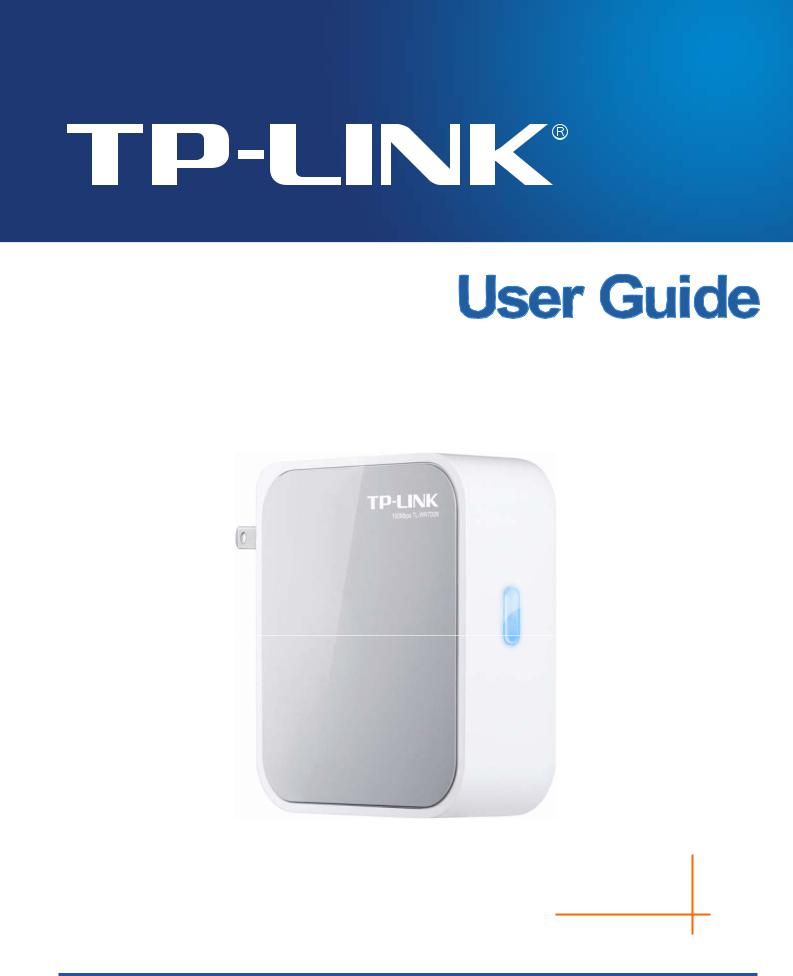
TL-WR700N
150Mbps Wireless N Mini Pocket Router
Rev: 1.0.0
1910010524

COPYRIGHT & TRADEMARKS
Specifications are subject to change without notice.  is a registered trademark of TP-LINK TECHNOLOGIES CO., LTD. Other brands and product names are trademarks or registered trademarks of their respective holders.
is a registered trademark of TP-LINK TECHNOLOGIES CO., LTD. Other brands and product names are trademarks or registered trademarks of their respective holders.
No part of the specifications may be reproduced in any form or by any means or used to make any derivative such as translation, transformation, or adaptation without permission from TP-LINK TECHNOLOGIES CO., LTD. Copyright © 2011 TP-LINK TECHNOLOGIES CO., LTD. All rights reserved.
http://www.tp-link.com
FCC STATEMENT
This equipment has been tested and found to comply with the limits for a Class B digital device, pursuant to part 15 of the FCC Rules. These limits are designed to provide reasonable protection against harmful interference in a residential installation. This equipment generates, uses and can radiate radio frequency energy and, if not installed and used in accordance with the instructions, may cause harmful interference to radio communications. However, there is no guarantee that interference will not occur in a particular installation. If this equipment does cause harmful interference to radio or television reception, which can be determined by turning the equipment off and on, the user is encouraged to try to correct the interference by one or more of the following measures:
•Reorient or relocate the receiving antenna.
•Increase the separation between the equipment and receiver.
•Connect the equipment into an outlet on a circuit different from that to which the receiver is connected.
•Consult the dealer or an experienced radio/ TV technician for help.
This device complies with part 15 of the FCC Rules. Operation is subject to the following two conditions:
1)This device may not cause harmful interference.
2)This device must accept any interference received, including interference that may cause undesired operation.
Any changes or modifications not expressly approved by the party responsible for compliance could void the user’s authority to operate the equipment.
Note: The manufacturer is not responsible for any radio or TVinterference caused by unauthorized modifications to this equipment. Such modifications could void the user’s authority to operate the equipment.
- I -

FCC RF Radiation Exposure Statement
This equipment complies with FCC RF radiation exposure limits set forth for an uncontrolled environment. This device and its antenna must not be co-located or operating in conjunction with any other antenna or transmitter.
“To comply with FCC RF exposure compliance requirements, this grant is applicable to only Mobile Configurations. The antennas used for this transmitter must be installed to provide a separation distance of at least 20 cm from all persons and must not be co-located or operating in conjunction with any other antenna or transmitter.”
CE Mark Warning
This is a class B product. In a domestic environment, this product may cause radio interference, in which case the user may be required to take adequate measures.
National restrictions
This device is intended for home and office use in all EU countries (and other countries following the EU directive 1999/5/EC) without any limitation except for the countries mentioned below:
Country |
Restriction |
Reason/remark |
|
|
|
|
|
Bulgaria |
None |
General authorization required for outdoor use and |
|
public service |
|||
|
|
||
|
|
|
Outdoor use limited to 10 France mW e.i.r.p. within the band
2454-2483.5 MHz
Military Radiolocation use. Refarming of the 2.4 GHz band has been ongoing in recent years to allow current relaxed regulation. Full implementation planned 2012
Italy |
None |
If used outside of own premises, general authorization is |
|
required |
|||
|
|
||
|
|
|
|
Luxembourg |
None |
General authorization required for network and service |
|
supply(not for spectrum) |
|||
|
|
||
|
|
|
|
Norway |
Implemented |
This subsection does not apply for the geographical area |
|
within a radius of 20 km from the centre of Ny-Ålesund |
|||
|
|
||
|
|
|
|
Russian Federation |
None |
Only for indoor applications |
|
|
|
|
Note: Please don’t use the product outdoors in France.
- II -

TP-LINK TECHNOLOGIES CO., LTD
DECLARATION OF CONFORMITY
For the following equipment:
Product Description: 150Mbps Wireless N Mini Pocket Router
Model No.: TL-WR700N
Trademark: TP-LINK
We declare under our own responsibility that the above products satisfy all the technical regulations applicable to the product within the scope of Council Directives:
Directives 1999/5/EC
The above product is in conformity with the following standards or other normative documents
ETSI EN 300 328 V1.7.1: 2006
ETSI EN 301 489-1 V1.8.1:2008& ETSI EN 301 489-17 V2.1.1:2009 EN60950-1:2006
Recommendation 1999/519/EC
EN62311:2008
Directives 2004/108/EC
The above product is in conformity with the following standards or other normative documents
EN 55022:2006 +A1:2007
EN 55024:1998+A1:2001+A2:2003 EN 61000-3-2:2006
EN 61000-3-3:1995+A1:2001+A2:2005
Directives 2006/95/EC
The above product is in conformity with the following standards or other normative documents
EN60950-1:2006
Directive ErP 2009/125/EC
Audio/Video, information and communication technology equipmentEnvironmentally conscious design
EN62075:2008
Person is responsible for marking this declaration:
Yang Hongliang
Product Manager of International Business
TP-LINK TECHNOLOGIES CO., LTD.
South Building, No.5 Keyuan Road, Central Zone, Science & Technology Park, Nanshan,
Shenzhen, P. R. China
|
CONTENTS |
|
Package Contents.................................................................................................................................. |
1 |
|
Chapter 1. |
Introduction....................................................................................................................... |
2 |
1.1 |
Overview of the Router ....................................................................................................... |
2 |
1.2 |
Conventions ........................................................................................................................ |
3 |
1.3 |
Main Features ..................................................................................................................... |
3 |
1.4 |
Panel Layout ....................................................................................................................... |
4 |
Chapter 2. Connecting the Router..................................................................................................... |
5 |
|
2.1 |
System Requirements......................................................................................................... |
5 |
2.2 |
Installation Environment Requirements .............................................................................. |
5 |
2.3 |
Connecting the Router ........................................................................................................ |
5 |
Chapter 3. Quick Installation Guide................................................................................................ |
10 |
|
3.1 |
TCP/IP Configuration ....................................................................................................... |
10 |
3.2 |
Quick Installation Guide ................................................................................................... |
12 |
Chapter 4. Configuration for AP Mode ........................................................................................... |
28 |
|
4.1 |
Login ................................................................................................................................ |
28 |
4.2 |
Status ............................................................................................................................... |
28 |
4.3 |
Quick Setup...................................................................................................................... |
30 |
4.4 |
Working Mode .................................................................................................................. |
30 |
4.5 |
Network ............................................................................................................................ |
31 |
4.6 |
Wireless ........................................................................................................................... |
32 |
4.7 |
DHCP ............................................................................................................................... |
41 |
4.8 |
System Tools.................................................................................................................... |
44 |
Chapter 5. Configuration for Router Mode .................................................................................... |
51 |
|
5.1 |
Login ................................................................................................................................ |
51 |
5.2 |
Status ............................................................................................................................... |
51 |
5.3 |
Quick Setup...................................................................................................................... |
54 |
5.4 |
Working Mode .................................................................................................................. |
54 |
5.5 |
Network ............................................................................................................................ |
55 |
5.6 |
Wireless ........................................................................................................................... |
64 |
5.7 |
DHCP ............................................................................................................................... |
74 |
5.8 |
Forwarding ....................................................................................................................... |
77 |
5.9 |
Security ............................................................................................................................ |
83 |
5.10 |
Static Routing................................................................................................................... |
91 |
5.11 |
IP QoS.............................................................................................................................. |
92 |
|
- I - |
|
5.12 |
IP & MAC Binding Setting ................................................................................................ |
94 |
5.13 |
Dynamic DNS................................................................................................................... |
96 |
5.14 |
System Tools.................................................................................................................... |
98 |
Chapter 6. Configuration for Repeater Mode .............................................................................. |
107 |
|
6.1 |
Login .............................................................................................................................. |
107 |
6.2 |
Status ............................................................................................................................. |
107 |
6.3 |
Quick Setup.................................................................................................................... |
108 |
6.4 |
Working Mode ................................................................................................................ |
109 |
6.5 |
Network .......................................................................................................................... |
109 |
6.6 |
Wireless .......................................................................................................................... |
110 |
6.7 |
DHCP .............................................................................................................................. |
112 |
6.8 |
System Tools................................................................................................................... |
116 |
Chapter 7. Configuration for Bridge Mode .................................................................................. |
122 |
|
7.1 |
Login .............................................................................................................................. |
122 |
7.2 |
Status ............................................................................................................................. |
122 |
7.3 |
Quick Setup.................................................................................................................... |
124 |
7.4 |
Working Mode ................................................................................................................ |
124 |
7.5 |
Network .......................................................................................................................... |
125 |
7.6 |
Wireless ......................................................................................................................... |
126 |
7.7 |
DHCP ............................................................................................................................. |
131 |
7.8 |
System Tools.................................................................................................................. |
135 |
Chapter 8. Configuration for Client Mode.................................................................................... |
142 |
|
8.1 |
Login .............................................................................................................................. |
142 |
8.2 |
Status ............................................................................................................................. |
142 |
8.3 |
Quick Setup.................................................................................................................... |
143 |
8.4 |
Working Mode ................................................................................................................ |
144 |
8.5 |
Network .......................................................................................................................... |
144 |
8.6 |
Wireless ......................................................................................................................... |
145 |
8.7 |
DHCP ............................................................................................................................. |
147 |
8.8 |
System Tools.................................................................................................................. |
151 |
Appendix A: FAQ .............................................................................................................................. |
158 |
|
Appendix B: Configuring the PC .................................................................................................... |
163 |
|
Appendix C: Specifications ............................................................................................................. |
167 |
|
Appendix D: Glossary...................................................................................................................... |
168 |
|
- II -

TL-WR700N 150Mbps Wireless N Mini Pocket Router
Package Contents
The following items should be found in your package:
One TL-WR700N 150Mbps Wireless N Mini Pocket Router
Quick Installation Guide
One RJ-45 Ethernet Cable
One Resource CD for TL-WR700N 150Mbps Wireless N Mini Pocket Router, including:
•User Guide
•Other Helpful Information
 Note:
Note:
Make sure that the package contains the above items. If any of the listed items is damaged or missing, please contact with your distributor.
線電通信。低功率射頻電機須忍受合法通信或工業、科學及醫療用電波輻射性電機設備之干擾。.
- 1 -

TL-WR700N 150Mbps Wireless N Mini Pocket Router
Chapter 1. Introduction
Thank you for choosing the TL-WR700N 150Mbps Wireless N Mini Pocket Router.
1.1 Overview of the Router
Small enough to fit in the average pocket, the TL-WR700N 150Mbps Wireless N Mini Pocket Router is uniquely suited to provide robust wireless networking to travelers, students, or anyone else for work or play.
Incredible Speed
TL-WR700N supports the newest 802.11n standards, and provides backward compatibility with older 802.11b/g standards as well. The up-to-150Mbps wireless speed makes it ideal for handling multiple data streams at the same time, which ensures your network stable and smooth.
Multiple Operation Modes
The TL-WR700N 150Mbps Wireless N Mini Pocket Router supports five operation modes. The AP mode enables the wired LAN to connect to the Internet wirelessly. The Router mode enables the TL-WR700N to work as a router for network sharing with high speed. The functions of Repeater mode and AP Bridge mode are similar, for they both make the TL-WR700N able to extend the existing wireless network. In Client mode, TL-WR700N acts as a wireless station to enable the wired host(s) to access AP.
Reliable Security Protections
With multiple protection measures, including SSID broadcast control and wireless LAN 64/128/152-bit WEP encryption, WiFi protected Access (WPA2-PSK, WPA-PSK), as well as advanced Firewall protections, the TL-WR700N 150Mbps Wireless N Mini Pocket Router provides complete data privacy.
Flexible Access Control
The TL-WR700N 150Mbps Wireless N Mini Pocket Router supports Virtual Server and DMZ host for Port Triggering, and then the network administrators can manage and monitor the network in real time with the remote management function.
Since the Router is compatible with virtually all the major operating systems, it is very easy to manage. Quick Setup Wizard is supported and detailed instructions are provided step by step in
- 2 -

TL-WR700N 150Mbps Wireless N Mini Pocket Router
this user guide. Before installing the Router, please look through this guide to know all the Router’s functions.
1.2 Conventions
The Router or TL-WR700N mentioned in this guide stands for TL-WR700N 150Mbps Wireless N Mini Pocket Router without any explanation.
Parameters provided in the pictures are just references for setting up the product, which may differ from the actual situation.
You can set the parameters according to your demand.
1.3 Main Features
¾Complies with IEEE 802.11n/g/b
¾Wireless speed up to 150Mbps
¾Foldable prongs
¾Travel size design, ideal for home or travel use
¾Compact and portable, powerful wireless signal as well
¾Perfectly compatible with almost all the 2.4GHz Wi-Fi devices
¾Supports AP, Router, Repeater, Bridge, and Client modes
¾Supports WEP, WPA/WPA2, WPA-PSK/WPA2-PSK encryptions
- 3 -
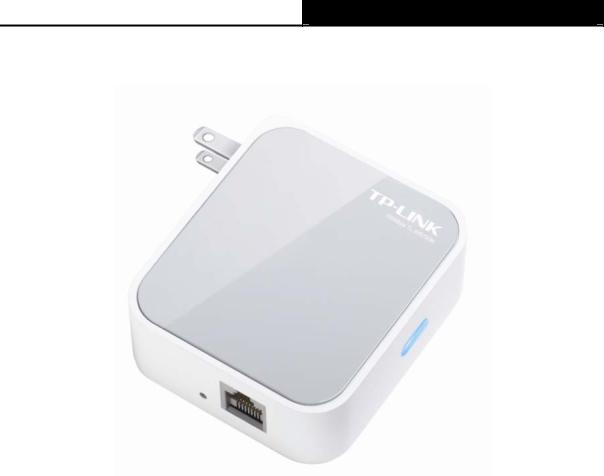
TL-WR700N 150Mbps Wireless N Mini Pocket Router
1.4 Panel Layout
Figure 1-1 TL-WR700N sketch
¾LED
|
Status |
|
Indication |
|
On |
|
The system is working properly. |
|
Flashing |
The LAN/WAN cable is connected. |
|
|
Off |
|
The system is working improperly, please check the |
|
|
device connection. |
|
|
|
|
|
|
|
|
Table 1-1 The LED Description |
¾LAN/WAN: This LAN/WAN port works as LAN in AP/Repeater/ Bridge/Client mode and as WAN in Router mode. As LAN, it connects the Router to the local PC; as WAN, it enables you connect the DSL/cable Modem, or Ethernet.
¾RESET It is used to reset the Router to its factory defaults. With the Router powered on, use a pin to press and hold the RESET button (about 5 seconds) until the SYS LED becomes quick-flash from slow-flash. And then release the button and wait the Router to reboot to its factory default settings.
¾Power Plug: Plug in standard electrical wall socket directly to power the Router.
- 4 -

TL-WR700N 150Mbps Wireless N Mini Pocket Router
Chapter 2. Connecting the Router
2.1 System Requirements
¾Each PC in the LAN needs a working Ethernet Adapter
¾TCP/IP protocol must be installed on each PC
¾Web browser, such as Microsoft Internet Explorer 5.0 or later, Mozilla Firefox, Apple Safari
¾If the device is configured to AP router mode, you also need Broadband Internet Access Service (DSL/Cable/Ethernet)
¾One DSL/Cable Modem that has an RJ45 connector (which is not necessary if the Router is connected directly to the Ethernet.)
2.2 Installation Environment Requirements
¾Place the Router in a well ventilated place far from any heater or heating vent
¾Place the Router in a location where it can be connected to the various devices as well as to a power source
¾Avoid direct irradiation of any strong light (such as sunlight)
¾Keep at least 2 inches (5 cm) of clear space around the Router
¾Operating Temperature: 0 ~40 (32 ~104 )
¾Operating Humidity: 10%~90%RH, Non-condensing
2.3 Connecting the Router
Before installing the Router, please make sure your broadband service provided by your ISP is available. If there is any problem, please contact with your ISP. To connect the Router, please follow the steps below:
1.Power off your PC, Cable/DSL Modem, and the Router.
2.Locate an optimum location for the Router. The best place is usually at the center of your wireless network. The place must accord with the Installation Environment Requirements.
3.Plug the power plug in the electrical wall socket. The Router will start to work automatically.
After finishing the steps above, please choose the operation mode you need and carry out the corresponding steps. There are five operation modes supported by this router: AP, Router, Repeater, Bridge and Client.
- 5 -
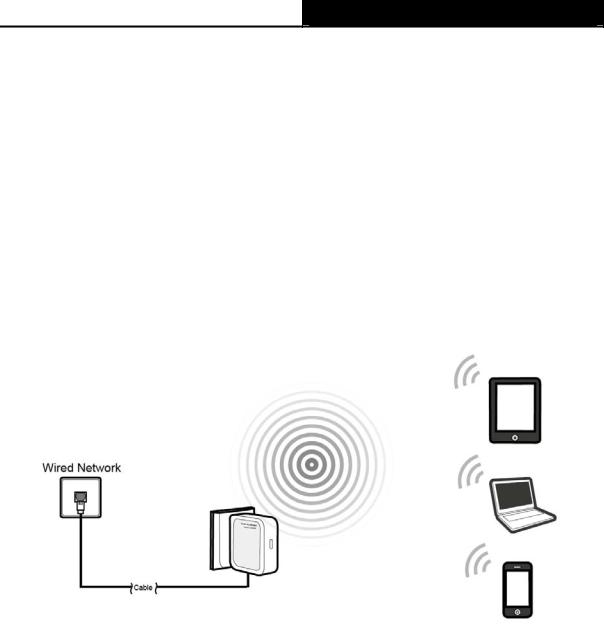
TL-WR700N 150Mbps Wireless N Mini Pocket Router
2.3.1 AP Mode
As the supplement of wired LAN, TL-WR700N enables the wired LAN to connect to the Internet wirelessly.
The default mode of TL-WR700N is AP. Plug the power plug of TL-WR700N in electrical wall socket and connect the Ethernet cable correctly, you can surf the Internet by connecting your PC(s) to the Router wirelessly.
On this mode, the only wired port works as LAN. Computer could connect to the device by either wired or wireless way. The Pre-encryption function is opened by default and the default password is the last unique eight numbers of each Router’s MAC address. To avoid the conflict of DHCP service with front-end devices, the DHCP server is default to be closed on this mode. If you want to login in the management page, please set your computer’s IP address manually.
Figure 2-1 Hardware Installation of the TL-WR700N in AP Mode
1.Connect the LAN port of TL-WR700N to the wired network port with an Ethernet cable.
2.Plug the power plug of TL-WR700N in electrical wall socket.
3.Power on the PC(s) and notebook(s).
2.3.2 Router Mode
As a wireless router, TL-WR700N enables multi-user to share Internet via DSL/Cable Modem.
On this mode, the only wired port works as WAN, which can be connected to DSL Modem with an Ethernet cable. Computers could connect to the device by only wireless way. DHCP server is default opened and it is recommended that the IP address and DNS server address obtained automatically.
- 6 -
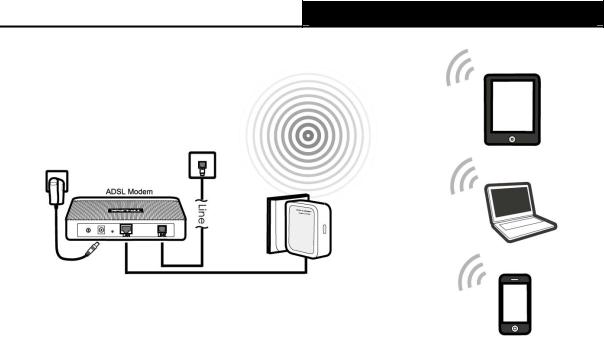
TL-WR700N 150Mbps Wireless N Mini Pocket Router
Figure 2-2 Hardware Installation of the TL-WR700N in Router Mode
1.Connect the WAN port of TL-WR700N to the LAN Port on the DSL/Cable Modem.
2.Connect the WAN port on the DSL/Cable Modem to the wired Internet.
3.Plug the power plug of TL-WR700N in electrical wall socket.
4.Power on the DSL/Cable Modem, PC(s) and notebook(s).
2.3.3 Repeater Mode
TL-WR700N is used to extend the range of wireless signal of the existing AP or wireless router.
On this mode, the only wired port works as LAN. Computer could connect to the device by either wired or wireless way. The SSID of TL-WR700N should be the same as that of the device you repeat. To avoid the conflict of DHCP service with front-end devices, the DHCP server is default to be closed on this mode. If you want to log in the management page, please set your computer’s IP address manually.
- 7 -
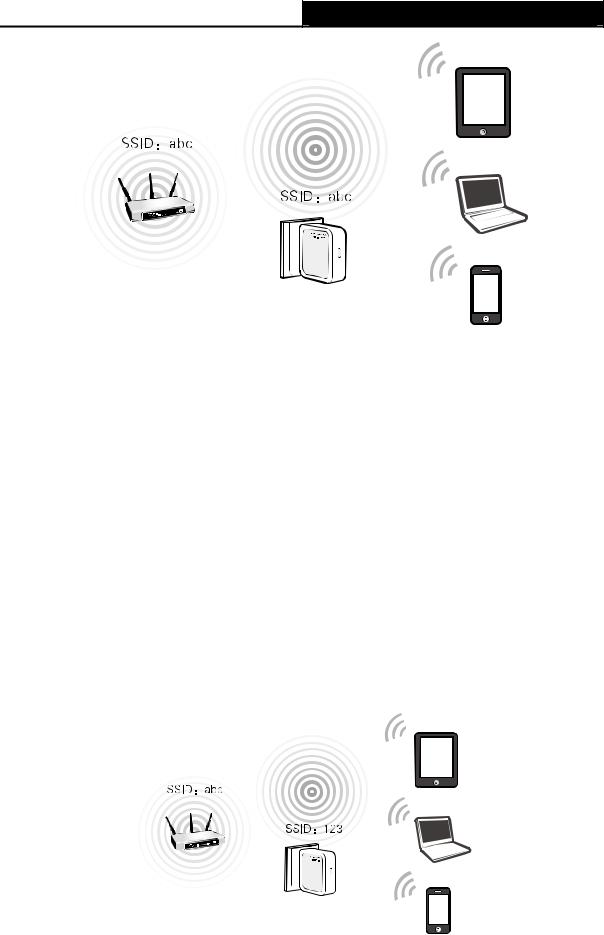
TL-WR700N 150Mbps Wireless N Mini Pocket Router
Figure 2-3 Hardware Installation of the TL-WR700N in Repeater Mode
1.Plug the power plug of TL-WR700N in electrical wall socket.
2.Power on the notebook(s).
) Note:
It is recommended that you connect a PC/notebook to the LAN port of the Router with an Ethernet cable, and then login the Router from the PC/notebook to set the Router in AP Repeater mode.
2.3.4 Bridge Mode
Similar to the Bridge mode, TL-WR700N in Bridge mode is also used to extend the range of wireless signal of the existing AP or wireless router.
On this mode, the only wired port works as LAN. Computer could connect to the device by either wired or wireless way. To avoid the conflict of DHCP service with front-end devices, the DHCP server is default to be closed on this mode. If you want to log in the management page, please set your computer’s IP address manually.
Figure 2-4 Hardware Installation of the TL-WR700N in Bridge Mode
- 8 -
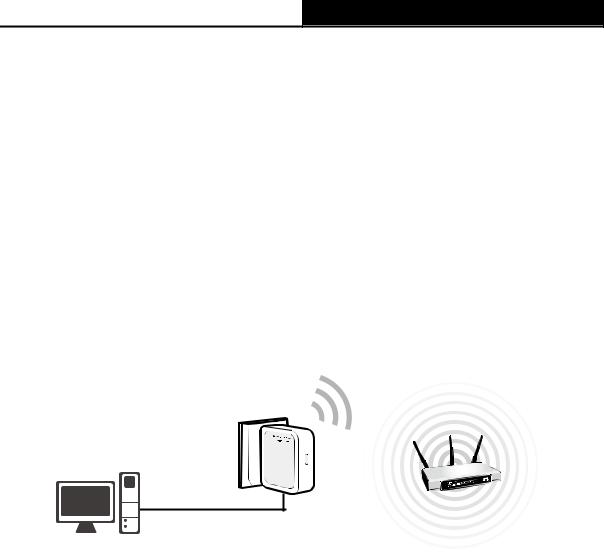
TL-WR700N 150Mbps Wireless N Mini Pocket Router
1.Plug the power plug of TL-WR700N in electrical wall socket.
2.Power on the notebook(s).
) Note:
It is recommended that you connect a PC/notebook to the LAN port of the Router with an Ethernet cable, and then login the Router from the PC/notebook to set the Router in Bridge mode.
2.3.5 Client Mode
TL-WR700N is used as a wireless network card to connect the wireless network signal or wireless router.
On this mode, the only wired port works as LAN. Computer could connect to the device by either wired or wireless way. To avoid the conflict of DHCP service with front-end devices, the DHCP server is default to be closed on this mode. If you want to log in the management page, please set your computer’s IP address manually.
Figure 2-5 Hardware Installation of the TL-WR700N in Client Mode
1.Connect the PC to the LAN/WAN port of TL-WR700N router with an Ethernet cable.
2.Plug the power plug of TL-WR700N in electrical wall socket.
3.Power on the PC(s).
- 9 -

TL-WR700N 150Mbps Wireless N Mini Pocket Router
Chapter 3. Quick Installation Guide
This chapter will show you how to configure the basic functions of your TL-WR700N 150Mbps Wireless N Mini Pocket Router using Quick Setup Wizard within minutes.
3.1 TCP/IP Configuration
The default IP address of the TL-WR700N 150Mbps Wireless N Mini Pocket Router is 192.168.0.254. And the default Subnet Mask is 255.255.255.0. These values can be changed as you desire. In this guide, we use all the default values for description.
Connect the local PC to the LAN/WAN port of the Router. And then you can configure the IP address for your PC in the following two ways.
¾Configure the IP address manually
1)Set up the TCP/IP Protocol for your PC. If you need instructions as to how to do this, please refer to Appendix B: "Configuring the PC".
2)Configure the network parameters. The IP address is 192.168.0.x ("x" is any number from 1 to 253), Subnet Mask is 255.255.255.0, and Gateway is 192.168.0.254 (The Router's default IP address).
¾Obtain an IP address automatically
1)Set up the TCP/IP Protocol in "Obtain an IP address automatically" mode on your PC. If you need instructions as to how to do this, please refer to Appendix B: "Configuring the PC”.
2)Then the built-in DHCP server will assign IP address for the PC.
Now, you can run the Ping command in the command prompt to verify the network connection between your PC and the Router. The following example is in Windows XP.
Open a command prompt, and type ping 192.168.0.254, and then press Enter.
¾If the result displayed is similar to the Figure 3-1, it means the connection between your PC and the Router has been established well.
- 10 -

TL-WR700N 150Mbps Wireless N Mini Pocket Router
Figure 3-1 Success result of Ping command
¾If the result displayed is similar to the Figure 3-2, it means the connection between your PC and the Router has failed.
Figure 3-2 Failure result of Ping command
Please check the connection following these steps:
1.Is the connection between your PC and the Router correct?
) Note:
The LED of LAN/WAN ports which you link to on the Router should be lit.
2.Is the TCP/IP configuration for your PC correct?
) Note:
If the Router's IP address is 192.168.0.254, your PC's IP address must be within the range of 192.168.0.1 ~ 192.168.0.253.
- 11 -
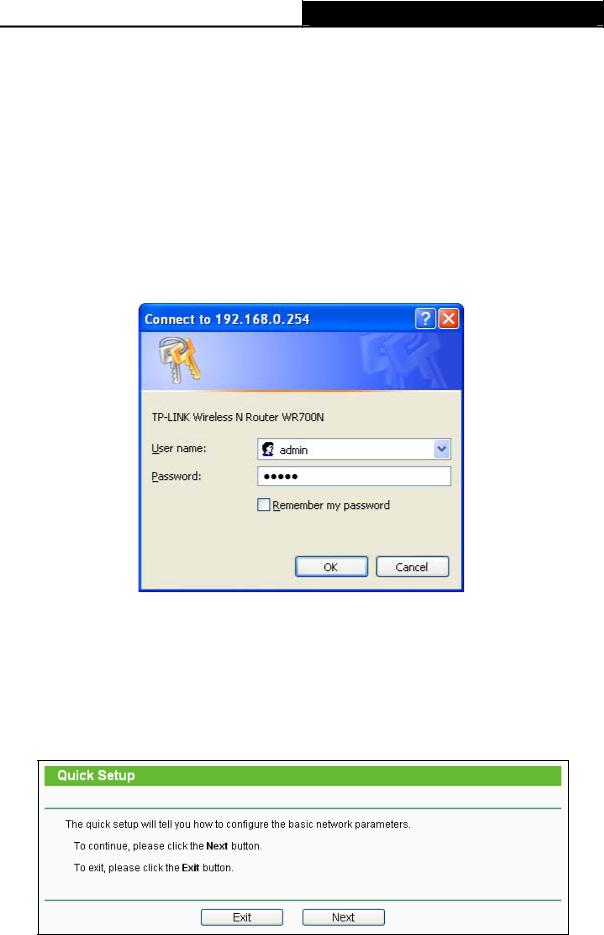
TL-WR700N 150Mbps Wireless N Mini Pocket Router
3.2 Quick Installation Guide
With a Web-based utility, it is easy to configure and manage the TL-WR700N 150Mbps Wireless N Mini Pocket Router. The Web-based utility can be used on any Windows, Macintosh or UNIX OS with a Web browser, such as Microsoft Internet Explorer, Mozilla Firefox or Apple Safari.
1.To access the configuration utility, open a web-browser and type in the default address http://192.168.0.254 in the address field of the browser.
After a moment, a login window will appear, similar to the Figure 3-3. Enter admin for the User Name and Password, both in lower case letters. Then click the OK button or press the
Enter key.
Figure 3-3 Login Windows
) Note:
If the above screen does not pop-up, it means that your Web-browser has been set to a proxy. Go to Tools menu>Internet Options>Connections>LAN Settings, in the screen that appears, cancel the Using Proxy checkbox, and click OK to finish it.
2.After a successfully login, you can click the Quick Setup menu to quickly configure your Router.
Figure 3-4 Quick Setup
- 12 -
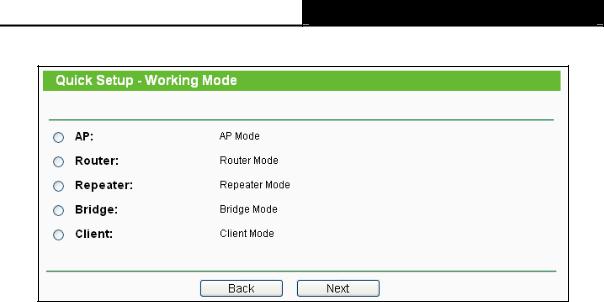
TL-WR700N 150Mbps Wireless N Mini Pocket Router
3.Click Next, and then Working Mode page will appear, shown in Figure 3-5.
Figure 3-5 Quick Setup - Working Mode
) Note:
The Router supports five working modes for multi-user to access the Internet: AP, Router, Repeater, Bridge and Client. In AP mode, TL-WR700N enables the wired LAN to connect to the Internet wirelessly. In Router mode, it can access the Internet via DSL/Cable Modem. In Repeater mode, the device will relay data to an associated root AP. In Bridge mode, the device bridges to another AP. In Client mode, the device will act as a wireless station to enable wired host(s) to access AP. You can configure your device quickly by the following steps in different modes.
3.2.1 AP Mode
When you choose AP on Working Mode page in Figure 3-5 , take the following steps:
1.Click Next in Figure 3-5, and then Wireless AP page will appear as shown in Figure 3-6.
- 13 -
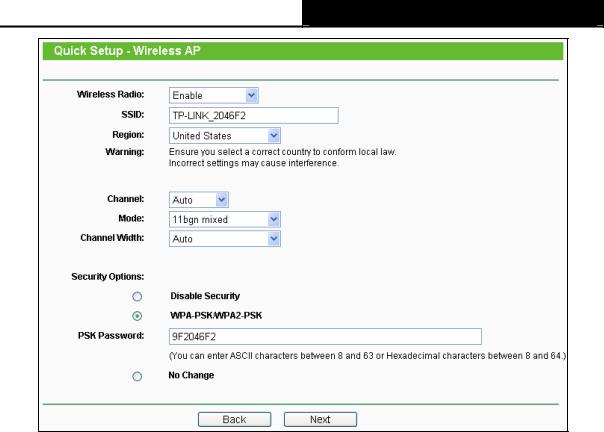
TL-WR700N 150Mbps Wireless N Mini Pocket Router
Figure 3-6 Quick Setup - Wireless AP
¾Wireless Radio - Enable or disable the wireless radio choosing from the pull-down list.
¾SSID - Enter a string of up to 32 characters. The same name of SSID (Service Set Identification) must be assigned to all wireless devices in your network. The default SSID is set to be TP-LINK_XXXXXX (XXXXXX indicates the last unique six numbers of each Router’s MAC address). But it is recommended strongly that you change your networks name (SSID) to a different value. This value is case-sensitive. For example, TEST is NOT the same as test.
¾Region - Select your region from the pull-down list. This field specifies the region where the wireless function of the Router can be used. It may be illegal to use the wireless function of the Router in a region other than one of those specified in this field. If your country or region is not listed, please contact your local government agency for assistance.
¾Channel - This field determines which operating frequency will be used. The default channel is set to Auto. It is not necessary to change the wireless channel unless you notice interference problems with another nearby access point.
¾Mode - Select the desired mode. The default setting is 11bgn mixed.
• 11b only - Select if all of your wireless clients are 802.11b.
• 11g only - Select if all of your wireless clients are 802.11g.
• 11n only- Select only if all of your wireless clients are 802.11n.
-14 -

TL-WR700N 150Mbps Wireless N Mini Pocket Router
•11bg mixed - Select if you are using both 802.11b and 802.11g wireless clients.
•11bgn mixed - Select if you are using a mix of 802.11b, 11g, and 11n wireless clients.
Select the desired wireless mode. When 802.11g mode is selected, only 802.11g wireless stations can connect to the Router. When 802.11n mode is selected, only 802.11n wireless stations can connect to the AP. It is strongly recommended that you set the Mode to 802.11b/g/n, and all of 802.11b, 802.11g, and 802.11n wireless stations can connect to the Router.
¾Channel Width - Select any channel width from the pull-down list. The default setting is automatic, which can automatically adjust the channel width for your clients.
¾Disable Security - The wireless security function can be enabled or disabled. If disabled, the wireless stations will be able to connect the Router without encryption. It is recommended strongly that you choose one of following options to enable security.
¾WPA-PSK/WPA2-PSK - Select WPA based on pre-shared passphrase.
•PSK Password - You can enter ASCII or Hexadecimal characters. The default password is the last unique eight numbers of each Router’s MAC address
For ASCII, the key can be made up of any numbers 0 to 9 and any letters A to Z, the length should be between 8 and 63 characters.
For Hexadecimal, the key can be made up of any numbers 0 to 9 and letters A to F, the length should be between 8 and 64 characters.
Please also note the key is case sensitive, this means that upper and lower case keys will affect the outcome. It would also be a good idea to write down the key and all related wireless security settings.
¾No Change - If you choose this option, wireless security configuration will not change!
2.Click the Next button. You will then see the Finish page.
If you don’t make any change on the Wireless page, you will see the Finish page as shown in Figure 3-7. Click the Finish button to finish the Quick Setup.
Figure 3-7 Quick Setup - Finish
- 15 -
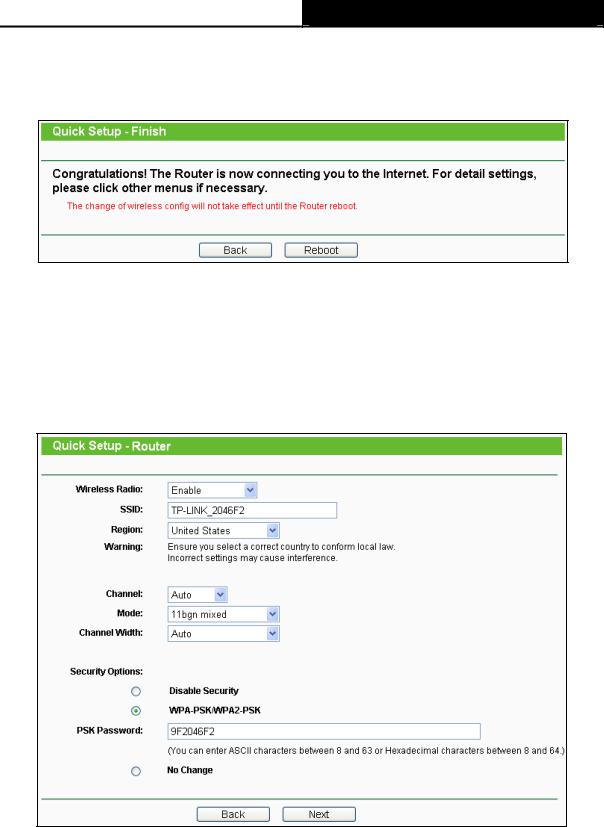
TL-WR700N 150Mbps Wireless N Mini Pocket Router
If there is something changed on the Wireless page, you will see the Finish page as shown in Figure 3-8. Click the Reboot button to make your wireless configuration take effect and finish the Quick Setup.
Figure 3-8 Quick Setup – Finish
3.2.2 Router Mode
When you choose Router on Working Mode page in Figure 3-5 , take the following steps:
1.Click Next in Figure 3-5, and you will see the following screen. The wireless settings on Router mode are the same as that on AP mode.
Figure 3-9 Quick Setup - Wireless Router
2.Click Next in Figure 3-9, and then WAN Connection Type page will appear as shown in
Figure 3-10.
-16 -
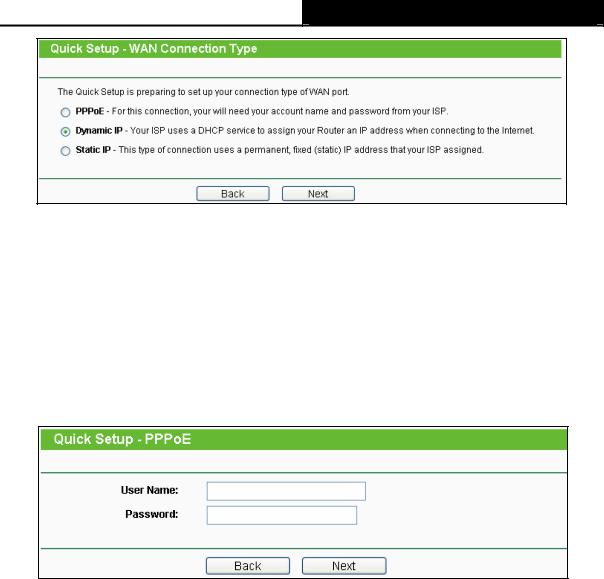
TL-WR700N 150Mbps Wireless N Mini Pocket Router
Figure 3-10 Quick Setup - WAN Connection Type
The Router supports three popular ways PPPoE, Dynamic IP and Static IP to connect to the Internet. To make sure the connection type your ISP provides, please refer to the ISP. Make sure the cable is securely plugged into the WAN port before detection.
¾PPPoE - For this connection, you will need your account name and password from your ISP.
If you have applied ADSL to realize Dial-up service, you should choose this type. Under this condition, you should fill in both the User Name and Password that the ISP supplied. Please note that these fields are case-sensitive.
Figure 3-11 Quick Setup - PPPoE
¾Dynamic IP - Your ISP uses a DHCP service to assign your Router an IP address when connecting to the Internet.
When the Router connects to a DHCP server, or the ISP supplies you with DHCP connection, please choose this type. The Router gets the IP address automatically from the DHCP server or the ISP if you choose Dynamic IP, and then the next screen will appear as shown in Figure 3-16. Then you can go on with the wireless configuration.
¾Static IP - This type of connection uses a permanent, fixed (static) IP address that your ISP assigned.
In this type, you should fill in the IP address, Subnet Mask, Default Gateway, and DNS IP address manually, which are specified by your ISP.
- 17 -
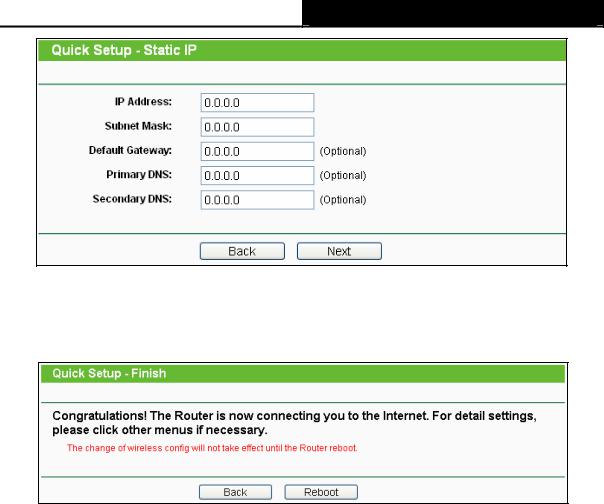
TL-WR700N 150Mbps Wireless N Mini Pocket Router
Figure 3-12 Quick Setup - Static IP
3.Click Next, you will see the Finish page as shown in Figure 3-13. Click the Reboot button to make your wireless configuration take effect and finish the Quick Setup.
Figure 3-13 Quick Setup – Finish
3.2.3 Repeater Mode
When you choose Repeater Mode on Working Mode page in Figure 3-5 , take the following steps:
1.Click Next, and then Wireless Repeater page will appear as shown in Figure 3-14.
- 18 -
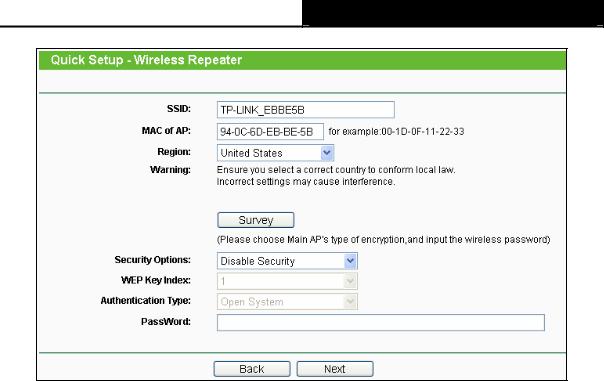
TL-WR700N 150Mbps Wireless N Mini Pocket Router
Figure 3-14 Quick Setup - Wireless Repeater
¾SSID - The SSID of AP that you want to access.
¾MAC of AP - The MAC address of AP that you want to access.
¾Region - Select your region from the pull-down list. This field specifies the region where the wireless function of the Router can be used. It may be illegal to use the wireless function of the Router in a region other than one of those specified in this field. If your country or region is not listed, please contact your local government agency for assistance.
¾Survey - Click this button, you can search the AP which runs in the environment.
¾Security Options - This option should be chosen according to the security configuration of the AP you want to access. It is recommended that the security type is the same as your AP’s security type.
¾WEP Key Index - This option should be chosen if the key type is WEP (ASCII) or WEP (HEX). It indicates the index of the WEP key.
¾Authentication Type - This option should be chosen if the key type is WEP (ASCII) or WEP (HEX). It indicates the authentication type of the Root AP.
¾Password - If the AP your router is going to connect need password, you need to fill the password in this blank.
Click Survey button on the Wireless page as shown in Figure 3-14, and then AP List page will appear as shown in Figure 3-15. Find the SSID of the Access Point you want to access, and click Connect in the corresponding row. For example, the third item is selected. The target network’s SSID will be automatically filled into the corresponding box which is shown as the Figure 3-14.
- 19 -
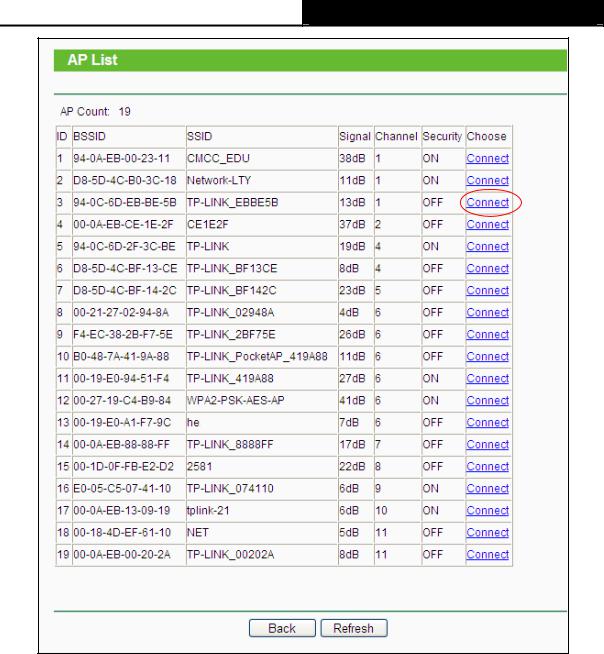
TL-WR700N 150Mbps Wireless N Mini Pocket Router
Figure 3-15 AP List
) Note:
If you know the SSID of the desired AP, you can also input it into the field "SSID" manually.
2.Click the Next button in Figure 3-14. You will then see the Finish page.
Because something has changed on the Wireless Repeater page, you will see the Finish page as shown in Figure 3-16. Click the Reboot button to make your wireless configuration take effect and finish the Quick Setup.
- 20 -
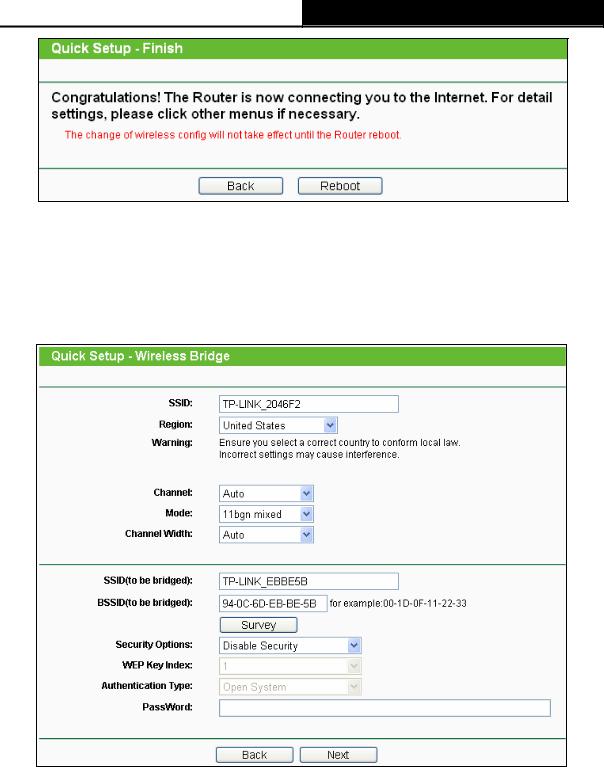
TL-WR700N 150Mbps Wireless N Mini Pocket Router
Figure 3-16 Quick Setup - Finish
3.2.4 Bridge Mode
When you choose Bridge on Working Mode page in Figure 3-5 , take the following steps:
1.Click Next, and then Wireless Repeater page will appear as shown in Figure 3-17.
Figure 3-17 Quick Setup - Wireless Bridge
¾SSID - Enter a string of up to 32 characters. The same name of SSID (Service Set Identification) must be assigned to all wireless devices in your network. The default SSID is set to be TP-LINK_XXXXXX (XXXXXX indicates the last unique six numbers of each Router’s MAC address). But it is recommended strongly that you change your networks name (SSID) to a different value. This value is case-sensitive. For example, TEST is NOT the same as test.
-21 -

TL-WR700N 150Mbps Wireless N Mini Pocket Router
¾Region - Select your region from the pull-down list. This field specifies the region where the wireless function of the Router can be used. It may be illegal to use the wireless function of the Router in a region other than one of those specified in this field. If your country or region is not listed, please contact your local government agency for assistance.
¾Channel - This field determines which operating frequency will be used. It is not necessary to change the wireless channel unless you notice interference problems with another nearby access point. If you select auto, then AP will choose the best channel automatically.
¾Mode - Select the desired mode. The default setting is 11bgn mixed.
11b only - Select if all of your wireless clients are 802.11b.
11g only - Select if all of your wireless clients are 802.11g.
11n only- Select only if all of your wireless clients are 802.11n.
11bg mixed - Select if you are using both 802.11b and 802.11g wireless clients.
11bgn mixed - Select if you are using a mix of 802.11b, 11g, and 11n wireless clients.
Select the desired wireless mode. When 802.11g mode is selected, only 802.11g wireless stations can connect to the Router. When 802.11n mode is selected, only 802.11n wireless stations can connect to the AP. It is strongly recommended that you set the Mode to 802.11b/g/n, and all of 802.11b, 802.11g, and 802.11n wireless stations can connect to the Router.
¾Channel width - Select the channel width from the pull-down list. The default setting is auto, which can automatically adjust the channel width for your clients.
) Note:
If 11b only, 11g only, or 11bg mixed is selected in the Mode field, the Channel Width selecting field will turn grey and the value will become 20MHz, which is unable to be changed.
¾SSID (to be bridged) - The SSID of the AP your Router is going to connect to as a client. You can also use the search function to select the SSID to join.
¾BSSID (to be bridged) - The BSSID of the AP your Router is going to connect to as a client. You can also use the search function to select the BSSID to join.
¾Survey - Click this button, you can survey the AP which runs in the environment.
¾Security Options - This option should be chosen according to the AP's security configuration. It is recommended that the security type is the same as your AP's security type.
¾WEP Key Index - This option should be chosen if the key type is WEP (ASCII) or WEP (HEX). It indicates the index of the WEP key.
¾Authentication Type - This option should be chosen if the key type is WEP (ASCII) or WEP (HEX). It indicates the authorization type of the Root AP.
-22 -
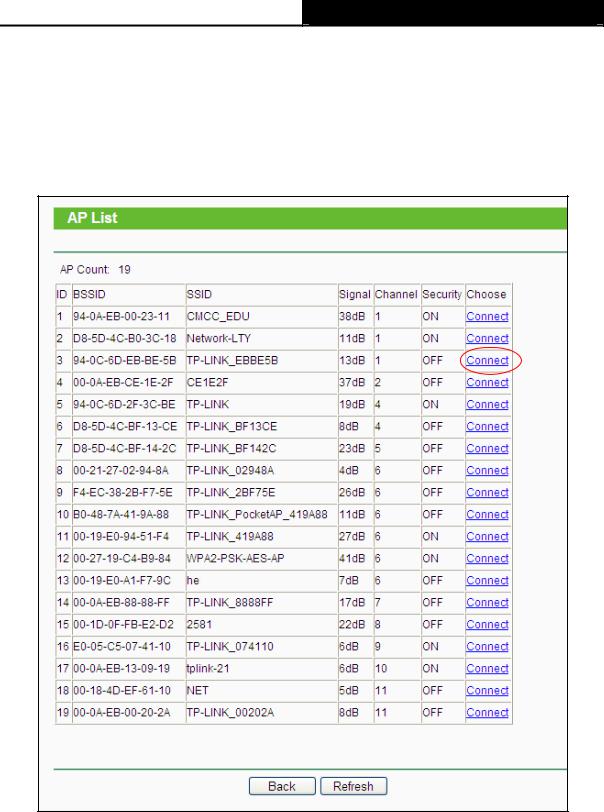
TL-WR700N 150Mbps Wireless N Mini Pocket Router
¾PassWord - If the AP your Router is going to connect needs password, you need to fill the password in this blank.
Click Survey button on the Wireless page as shown in Figure 3-17, and then AP List page will appear as shown in Figure 3-18. Find the SSID of the Access Point you want to access, and click Connect in the corresponding row. For example, the third item is selected. The target network’s SSID will be automatically filled into the corresponding box which is shown as the Figure 3-17.
Figure 3-18 AP List
2.Click Next in Figure 3-17, and then Wireless Security Settings page will appear as shown in Figure 3-19.
-23 -
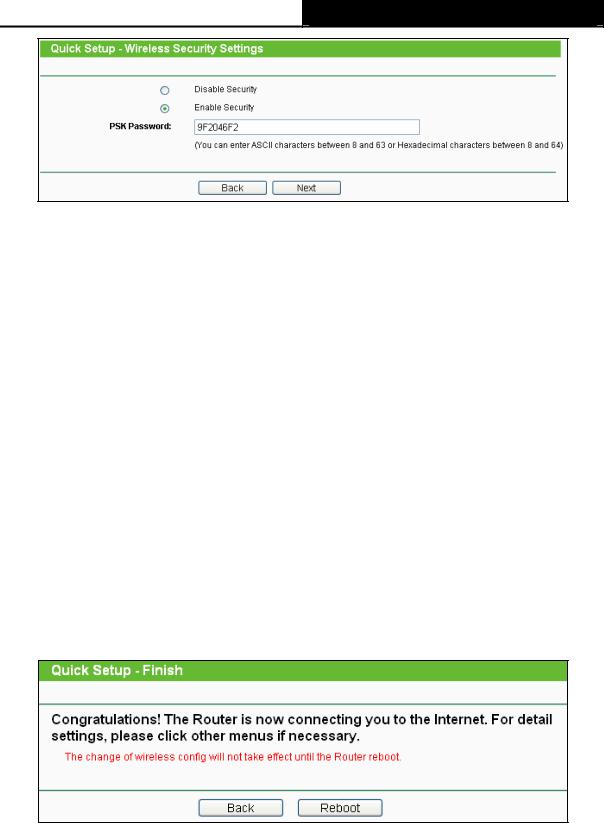
TL-WR700N 150Mbps Wireless N Mini Pocket Router
Figure 3-19 Quick Setup - Wireless Security Settings
This page is for setting wireless security of your own AP. When computers and mobile phones are connected to the AP, they should input the same password.
¾Disable Security - The wireless security function can be enabled or disabled. If disabled, the wireless stations will be able to connect the Router without encryption. It is recommended strongly to enable security.
¾PSK Password - ou can enter ASCII or Hexadecimal characters. The default password is the last unique eight numbers of each Router’s MAC address
For ASCII, the key can be made up of any numbers 0 to 9 and any letters A to Z, the length should be between 8 and 63 characters.
For Hexadecimal, the key can be made up of any numbers 0 to 9 and letters A to F, the length should be between 8 and 64 characters.
Please also note the key is case sensitive, this means that upper and lower case keys will affect the outcome. It would also be a good idea to write down the key and all related wireless security settings.
3.Click the Next button in Figure 3-20. You will then see the Finish page. Click the Reboot button to make your wireless configuration take effect and finish the Quick Setup.
Figure 3-20 Quick Setup - Finish
3.2.5 Client Mode
When you choose Client on Working Mode page in Figure 3-5 , take the following steps:
1.Click Next in Figure 3-5, and then Wireless Client page will appear as shown in Figure 3-21.
-24 -
